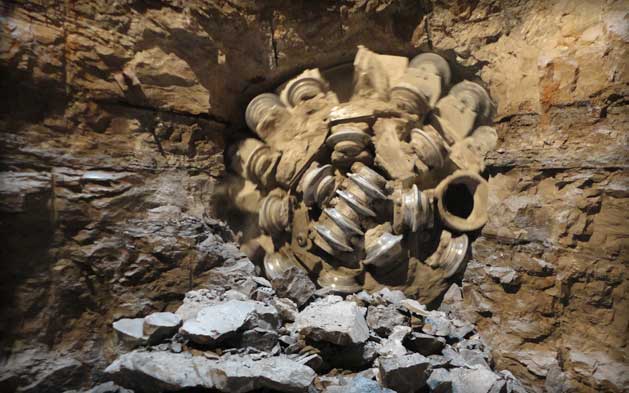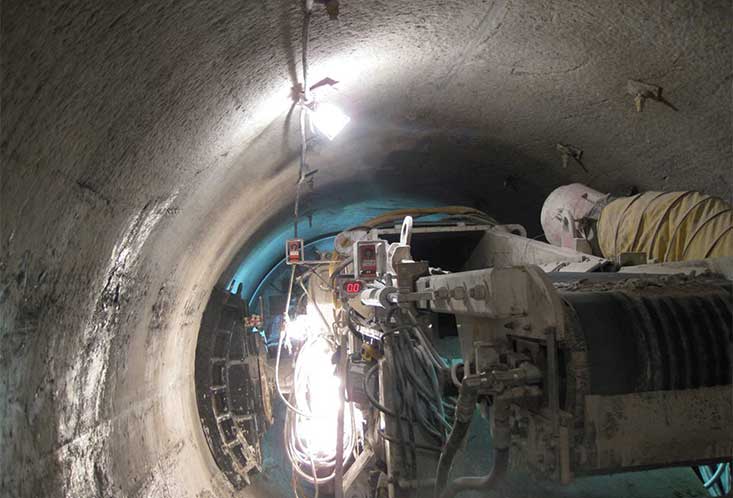St Louis mega-CSO program to span 44km 25 Mar 2015
Construction schedule is announced in St Louis, USA, for a major program of CSO storage and conveyance tunnels totaling more than 44km in length. In announcing the US$1.7 billion program of works – known as Project Clear – St Louis Metropolitan Sewer District (MSD) puts the tunnel construction industry on alert for construction opportunities.
| Table 1. St Louis Sewer District Project Clear Program | |||||
| Project | Length (m) | Diameter | Const’n start [**] | Const’n duration | Cost ($m) |
| Maline Creek CSO Storage Facility [*] | 914 | 8.53 | 2016 | 5 years | 81 |
| Deer Creek Sanitary Tunnel [*] | 6,401 | 5.79 | 2017 | 4 years | 300 |
| Jefferson Barracks Tunnel [*] | 5,182 | 2.13 | 2017 | 4years | 89 |
| Lower/Middle Des Peres Storage Tunnel [*] | 14,484 | 9.14 | 2020 | 7 years | 631 |
| University City Storage Facility | 381 | 9.14 | 2018 | 2 years | 40 |
| Lower Meramec Tunnel | 10,944 | 2.44 | 2020 | 5 years | 170 |
| River Des Peres Tributaries CSO Tunnel | 3,701 | 6.1 | 2024 | 7 years | 375 |
| Upper Des Peres CSO Storage Tunnel | 2,736 | 7.31 | 2028 | 7 years | 226 |
[*]Design is under way [**]Estimated
“Construction on the eight remaining tunnels is planned to begin over the next dozen years,” said MSD Executive Director Brian Hoelscher. “These tunnels represent significant work opportunities for the construction industry with the second tunnel expected to go to bid as early as 2016, followed by four more tunnels beginning construction in 2017. These next five tunnels have an estimated construction cost of over US$1 billion.”
Metropolitan St Louis Sewer District (MSD) manages the fourth largest sewer collection system in the United States (11,264km in total). Project Clear is a Federally mandated multi-billion dollar investment to address wastewater overflows, alongside building community rainscaping, system improvements, and a program of maintenance and repair throughout the system serving the St Louis region. In total the project is worth US$4.7 billion, with tunnel construction expected to account for some 40% of the total cost.
The nine tunnels that are planned will significantly reduce sewer overflows as part of MSD’s Long Term Control Plan to bring the District into compliance with the US Environmental Protection Act. Construction of the first tunnel is nearing completion, while plans for the remaining eight tunnels are under way.
“We want the construction industry to be aware of these upcoming opportunities and plan accordingly,” said Hoelscher.
MSD and its designer Jacobs Engineering is already planning construction procurement for the next three tunnels in the program, the first of which will be the 914m x 8.53m diameter Maline Creek CSO Storage Facility. Construction of the Maline facility is scheduled to start next year (2016), followed in 2017 by the 6,401m x 5.79m diameter Deer Creek Sanitary Tunnel and the 5,182m x 2.13m diameter Jefferson Barracks Tunnel.
MSD and Jacobs Engineering will present further detail about three of the tunnels at the RETC in New Orleans in June as part of a paper entitled St. Louis’ Sewer Tunnel Vision. The paper will describe the Maline Creek CSO Storage Facility, the Jefferson Barracks Tunnel, and Project Clear’s highest value facility, the 14,484m x 9.14m diameter Lower & Middle River Des Peres Storage Tunnel.
Lemay TBM operations
Project Clear reached a milestone last year (2014) with the completion by SAK Construction of the first phase of a 975m x 3.4m diameter tunnel as part of the US$20 million Lemay Redundant Force Main project. TBM operations using a refurbished Robbins Main Beam started in February and were completed by May 2014, with surface connections expected to complete later this year (2015).
Boring through limestone and dolomite ranging from 48–130 MPa (7,000–19,000 psi), the TBM excavated up to 39m in a single day and 158m in a single week. Ground support included installation of two 1.4m long resin-encased rockbolts at 1.2m intervals. “Blocky ground was our biggest challenge,” explained Brent Duncan, Tunnel Project Manager for SAK. He estimated that 15–20% of the bore consisted of the more difficult ground conditions: “As there was no finger shield on this machine, we installed the rockbolts about 13ft back from the cutterhead support, making ground stabilization a challenge.” The crew surmounted the obstacle by adding 1.2m x 1.2m wire mesh panels and steel straps to the crown in sections of blocky rock.
In constructing this second force main, the Lemay Wastewater Treatment Plant will be able to accept a higher volume of wastewater, enabling MSD to inspect the original force main for the first time since its construction in the 1960s.
References
- CSO mega-project prompts Jacobs St Louis expansion – TunnelTalk, March 2014
- Green surge threatens CSO storage solution – TunnelTalk, June 2013
- DC Water scales back CSO tunnel plans – TunnelTalk, January 2014
|
|
|
|
|
Add your comment
- Thank you for taking the time to share your thoughts and comments. You share in the wider tunnelling community, so please keep your comments smart and civil. Don't attack other readers personally, and keep your language professional.




